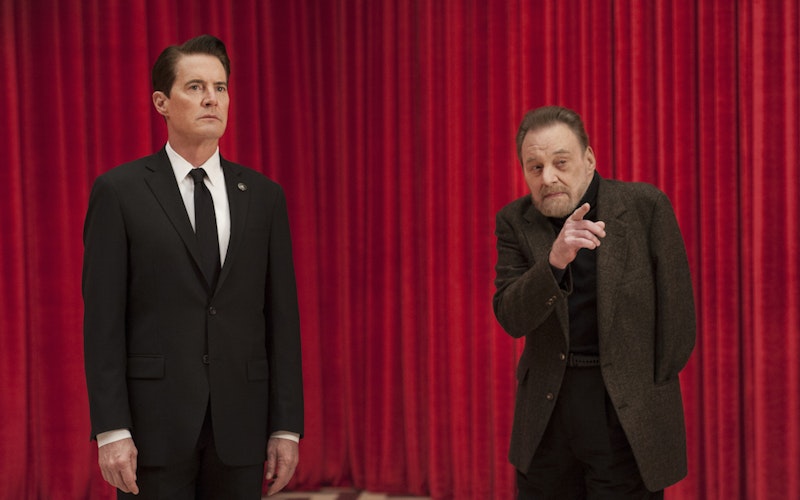
TV
Twin Peaks’ Spiritual Warfare
When Twin Peaks recently returned to Showtime with its first new episode in nearly 26 years, fans experienced something both familiar and perplexing. No moment better captured this sensation than when detectives in Buckhorn, S.D., arrest Bill Hastings (Matthew Lillard), a respected and affable high-school principal, for the brutal murder of a librarian with whom he was having an affair. Lillard plays Hastings as a man of moral fortitude, even as crime-scene evidence undermines his innocence. Worse, Bill admits that, on the night of the murder, he visited the librarian’s apartment in a dream.
Longtime Peaks fans have seen this before, as the original two seasons centered on the killing of beloved prom queen Laura Palmer (Sheryl Lee) at the hands of an upstanding citizen who was admired by neighbors. That investigation by Special Agent Dale Cooper (Kyle MacLachlan) uncovered years of sexual abuse and violence within the titular logging town.
Stories about idyllic communities with dark secrets were already cliché when the Peaks pilot aired in 1990, but creators Mark Frost and David Lynch distinguished their vision by placing it within a supernatural cosmology. This paranormal aspect spawned some of the series’ most memorable characters: the dancing, backwards-speaking little person (Michael J. Anderson); The Giant (Carel Struycken), who warns Agent Cooper of duplicitous owls; and, of course, the demonic Killer Bob (originally played by Frank Silva), who made good men into murderers and might be now controlling Bill Hastings.
Twin Peaks fuses the natural and spiritual by making mundane settings feel otherworldly, such as the suburban living room in the “Lonely Souls” episode of season two. Lynch increases the horror by filling the soundtrack with the mechanical rhythm of a needle bumping against the end of a record. He holds his camera far too long on a hallway and a ceiling fan, making their banality seem sinister, before shining a literal spotlight on a white horse and then on the victim. These details suggest a supernatural presence within the everyday, yet the series never clarifies what people do through Killer Bob’s manipulation and what they do of their own volition. We simply know that hidden indiscretions allow Bob influence over his agents.
Given Lynch’s signature use of dream logic, it’s neither useful nor satisfying to attempt a coherent statement about the metaphysics of Twin Peaks. The series works on an intuitive level. As I watch, I’m reminded of the warnings made by the first apostles against giving “a foothold” to the devil, who “prowls around like a roaring lion.” Paul develops this notion in 2 Corinthians 10, which teaches the church to use weapons that are spiritual, not worldly. The former, he explains, begins with one’s mental life, and he urges readers to “take captive every thought to make it obedient to Christ.”
Twin Peaks fuses the natural and spiritual by making mundane settings feel otherworldly.
More than a mere set of boundaries, this admonition builds upon the concept of rebirth that Paul introduced earlier in the letter, when he declared, “if anyone is in Christ, the new creation has come: The old has gone, the new is here.” As a new creation, transformed by the Holy Spirit, our thoughts and deeds should be in accordance with Christ. With its harrowing violence and surreal imagery, Twin Peaks demonstrates that even the most covert wrongs on the spiritual level can lead to serious harm.
At the same time, the series also celebrates acts of kindness and grace, no matter how trite. Square-jawed Agent Cooper, whose indefatigable optimism and zeal for coffee provide a welcome contrast to the show’s more disturbing elements, best embodies this idea. In the same way that secret sins expose some to demonic influence, Cooper’s virtues align him with mystical forces that are opposed to Bob’s corruption.
When the series ended in 1991, it did so with a tantalizing cliffhanger: Cooper, overcome by self-doubt, gets trapped in the purgatorial Black Lodge and replaced by an evil, Bob-influenced doppelgänger. The 2017 season follows the good and evil versions of Cooper, depicting both the dehumanizing effects of a sinful life and the potential for redemption.
Consider the close of a recent episode, “The Return: Part 4.” Held in a South Dakota prison, the evil Cooper appeals to former FBI colleagues Cole (Lynch) and Rosenfeld (Miguel Ferrer) by flashing Cooper’s characteristic smile and thumbs up. But something is off. Placing the camera behind the shoulders of Rosenfeld and Cole, highlighting the console they sit at and the glass and bars of Cooper’s cell, Lynch underscores the distance not only between the agents and their erstwhile friend, but also between the audience and a beloved character. When the bad Cooper limply raises his thumb and contorts his face into a smile, we see our hero perverted.
Conversely, the preceding scene features the good Cooper, out from the Black Lodge but now a mindless suburban dad named Dougie Jones (for reasons that don’t make much sense). MacLachlan refrains from playing the character as he did in the 1990s episodes, instead restricting him to affectless stares and one-word statements. Yet as he sits at a brightly lit kitchen table, accompanied by a jaunty Angelo Badalamenti score, Cooper/Dougie takes his first sip from a mug of coffee. He retches, but looks up with a friendly smile of recognition. This is finally our Cooper, despite the loud green blazer and coffee dribbling down his chin.
The moment promises to be the first sign of restoration, a hint that Cooper’s defining gentleness and warmth will return. If so, Twin Peaks further dramatizes Paul’s lesson to discipline the mind for spiritual warfare, while also offering a glimpse of spiritual renewal.
Topics: TV, Culture At Large, Arts & Leisure